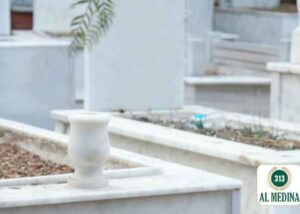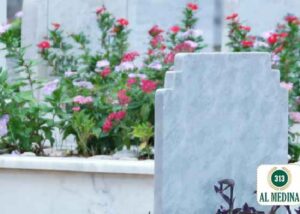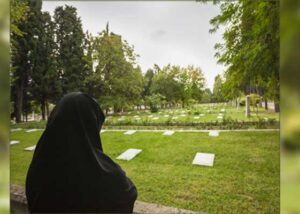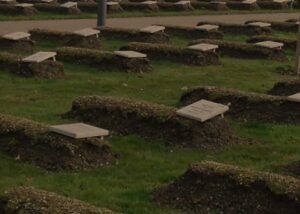Quran
Hadith
Islamic Text
It is not permitted to build on graves according to the Hanafi Madhab. This is due to the explicit prohibition by the Holy Prophet ﷺ in Sahih Muslim.
عَنْ جَابِرٍ، قَالَ: نَهَى رَسُولُ اللهِ صَلَّى اللهُ عَلَيْهِ وَسَلَّمَ أَنْ يُجَصَّصَ الْقَبْرُ، وَأَنْ يُقْعَدَ عَلَيْهِ، وَأَنْ يُبْنَى عَلَيْهِ
(Sayidina) Jabir (May Allah Most High be pleased with him) said, the Messenger of Allah ﷺ prohibited plastering over a grave, or sitting upon it, or building upon it. (Sahih Muslim, 970 – 94).
Similar Hadith narrations that prohibit building upon graves have also been narrated by Imam Abu Dawood (3225), Imam al-Nasai (2028), Imam Ahmad (14148), Imam Ibn Maja (1564), Imam Ibn Hibban (3163 and 3164). There is no doubt regarding the authenticity of the Hadith in Muslim since all Musnad Hadith in Bukhari and Muslim are Sahih.
Due to the clear prohibition in the Hadith, the Hanafi scholars considered the sound opinion to be that it is prohibited to build upon graves. This is mentioned in many classical Hanafi works. The Nusoos (texts) below are just a sample and should not be considered an exhaustive list.
وَكره أَبُو حنيفَة الْبناء على الْقَبْر. (تحفة الفقهاء)
(Imam) Abu Hanifah considered it Makruh to build upon a grave. (Imam Ala al-Deen al-Samarqandi, Tuhfatu al-Fuqahaa).
وَكَرِهَ أَبُو حَنِيفَةَ الْبِنَاءَ عَلَى الْقَبْرِ. (بدائع الصنائع)
(Imam) Abu Hanifah considered it Makruh to build upon a grave. (Imam Abu Bakr al-Kaasaani, Badai al-Sanai).
روي عن أبي حنيفة رحمه الله تعالى أنه قال لا يجصص القبر ولا يطين ولا يرفع عليه بناء. (فتاوى قاضيخان)
And it has been narrated from Abu Hanifah, May Allah Most High have mercy upon him, that a grave must not be plastered, nor covered with clay, and a building must not be erected upon it. (Imam Qadi Khan).
وَيكْرَهُ أَنْ يُبْنَى عَلَى الْقَبْرِ. (بيين الحقائق شرح كنز الدقائق)
And it is Makruh to build upon a grave. (Imam Fakhr al-Deen al-Zayla’i, Tabyeen al-Haqaaiq).
Many of the Hanafi Imams quoted the Hadith above when they mentioned the prohibition upon building on graves. And many Imams of Hadith science dedicated chapters to Hadith about the prohibition of building upon graves.
منع الْبناء على الْقَبْر، لِأَن أَبَا دَاوُد أخرج هَذَا الحَدِيث فِي بَاب الْبناء على الْقَبْر. (عمدة القاري شرح صحيح البخاري)
It is not permitted to build upon graves. (Imam) Abu Dawood narrated this Hadith in the chapter of building upon graves. (Imam Badr al-Deen al-Ayni, Umdatu al-Qari).
وَلَا يُرْفَعُ عَلَيْهِ بِنَاءٌ. (البحر الرائق شرح كنز الدقائق)
And a building is not to be erected upon it (a grave). (Imam Ibn Nujaym, al-Bahr al-Raqi).
وَيُكْرَهُ أَنْ يُبْنَى عَلَى الْقَبْرِ. (الفتاوى الهندية)
And it is Makruh to build upon a grave. (al-Fatawaa al-Hindiyah).
Unfortunately, some people try to present this as a sectarian issue to do with Deobandis and Barelvis. Whereas, this issue is not related to these groups, it is an issue explicitly mentioned in Hadith and classical works of the Hanafi Madhab that predate these groups by centuries.
Another mistake that has been made recently regarding the issue of building upon graves is a misrepresentation of some authoritative Hanafi works. Firstly, it was claimed that the chosen opinion in al-Durr al-Mukhtar was that of permissibility. This is an error, as clarified in the commentary by Imam Ibn Abideen. It is also important to clarify that the statement that was referred to was not a statement of Imam al-Haskafi rather it was from the Matn. Therefore, it was a statement of Imam al-Tumurtashi.
(وَلَا يُطَيَّنُ، وَلَا يُرْفَعُ عَلَيْهِ بِنَاءٌ. وَقِيلَ: لَا بَأْسَ بِهِ، وَهُوَ الْمُخْتَارُ) كَمَا فِي كَرَاهَةِ السِّرَاجِيَّةِ
(قَوْلُهُ: وَقِيلَ: لَا بَأْسَ بِهِ إلَخْ) الْمُنَاسِبُ ذِكْرُهُ عَقِبَ قَوْلِهِ: وَلَا يُطَيَّنُ لِأَنَّ عِبَارَةَ السِّرَاجِيَّةِ كَمَا نَقَلَهُ الرَّحْمَتِيُّ ذَكَرَ فِي تَجْرِيدِ أَبِي الْفَضْلِ أَنَّ تَطْيِينَ الْقُبُورِ مَكْرُوهٌ وَالْمُخْتَارُ أَنَّهُ لَا يُكْرَهُ اهـ وَعَزَاهُ إلَيْهَا الْمُصَنِّفُ فِي الْمِنَحِ أَيْضًا. وَأَمَّا الْبِنَاءُ عَلَيْهِ فَلَمْ أَرَ مَنْ اخْتَارَ جَوَازَهُ. وَفِي شَرْحِ الْمُنْيَةِ عَنْ مُنْيَةِ الْمُفْتِي: الْمُخْتَارُ أَنَّهُ لَا يُكْرَهُ التَّطْيِينُ. وَعَنْ أَبِي حَنِيفَةَ: يُكْرَهُ أَنْ يَبْنِيَ عَلَيْهِ بِنَاءً مِنْ بَيْتٍ أَوْ قُبَّةٍ أَوْ نَحْوِ ذَلِكَ، لِمَا رَوَى جَابِرٌ «نَهَى رَسُولُ اللَّهِ – صَلَّى اللَّهُ عَلَيْهِ وَسَلَّمَ – عَنْ تَجْصِيصِ الْقُبُورِ، وَأَنْ يُكْتَبَ عَلَيْهَا، وَأَنْ يُبْنَى عَلَيْهَا» رَوَاهُ مُسْلِمٌ وَغَيْرُهُ اهـ
Imam al-Tumurtashi: And it (the grave) should not be plastered with clay. And a building must not be erected upon it. And it has been said that there is no harm in it. And that is the chosen position.
Imam al-Haskafi: As has been mentioned in the section on disliked matters in al-Sirajiyyah.
Imam Ibn Abideen: His saying, and it has been said there is no harm in it… It would have been more appropriate to mention this after his saying,’ And it (the grave) should not be plastered with clay.’ Since the text in al-Sirajiyyah, as narrated by al-Rahmati in the Tajreed of Abi al-Fadl is, plastering a grave with clay is Makruh. However the chosen position is that it is not Makruh. He cited it to the author in al-Minah too. As for building upon it, I have not seen anyone choosing an opinion permitting it.
In the commentary of al-Munyah from Munyatu al-Mufti: The chosen position is that it is not Makruh to plaster it with clay. It is narrated from (Imam) Abu Hanifah that it is Makruh to erect a building upon it, or a dome or the like of it. This is due to what (Sayidina) Jabir narrated: The Messenger of Allah ﷺ prohibited plastering over a grave, or writing upon it, or building upon it. It was narrated by Muslim and others. (Radd al-Muhtar).
As seen above, if one simply checks the commentary then the issue is clarified. Imam al-Tumurtashi was not claiming that the sound position is that one can build upon a grave. Rather, he was commenting upon the issue of plastering a grave with clay. Imam Ayni also clarified this issue:
في ” المحيط “: لا يجص القبر ولا يطين، في رواية الكرخي، وكره التجصيص الحسن والنخعي، والثوري، ومالك، والشافعي، وأحمد، وأباح أحمد التطيين. وفي ” منية المفتي “: المختار أنه لا يكره، وكره أبو حنيفة أن يبنى على القبر أو يوطأ عليه. (البناية شرح الهداية)
In al-Muheet (he said), A grave is not plastered with gypsum nor covered with clay according to the narration from (Imam) al-Karkhi. And plastering with gypsum was disliked by (Imam) al-Hasan (al-Basri), (Imam) al-Nakhai, (Imam) al-Thowri, (Imam) Malik, (Imam) al-Shafi and (Imam) Ahmad. Although (Imam) Ahmad considered plastering with clay to be permitted. He said in Munyatu al-Mufti: The chosen opinion is that it is not Makruh. And Abu Hanifah disliked building upon a grave or stepping upon it. (Imam Badr al-Deen al-Ayni, al-Binayah).
Secondly, it has been claimed that Imam al-Tahtawi did not consider domes upon graves to be prohibited. This is a clear error. Imam al-Tahtawi was explicit regarding this issue when commenting upon Maraaqi al-Falah.
“ويكره” البناء عليه “للإحكام بعد الدفن” لأنه للبقاء والقبر للفناء. (مراقي الفلاح شرح نور الإيضاح)
And it is disliked to build upon it (a grave) to strengthen it after burial. As that is for preservation, and the grave or is obliteration. (Nur al-Idaah and Maraaqi al-Falah).
قوله (ويكره البناء عليه) ظاهر إطلاقه الكراهة أنها تحريمية قال في غريب الخطابي نهى عن تقصيص القبور وتكليلها انتهى التقصيص التجصيص والتكليل بناء الكاسل وهي القباب والصوامع التي تبنى على القبر. (حاشية الطحطاوي على مراقي الفلاح)
His saying: It is disliked to build upon it. The apparent of this general statement is that it is Tahreemi. He said in Ghareeb al-Khattabi, Taqsees and Takleel of graves is prohibited. Taqsees is plastering with gypsum. Takleel is the building of al-Kaasil. Which refers to domes and tall structures that are built upon graves. (Haashiyah al-Tahtaawi).
It should be abundantly clear to any objective, non-sectarian, individual that the position of the Hanafi Madhab is that of prohibiting building upon graves. However, there is always room for exceptions in situations of necessity. This was mentioned by some Hanafi scholars, giving the threat of grave robbers as a possible reason to reinforce graves (see link below for details).
There is some difference of opinion amongst Hanafi scholars if the grave being built upon is that of a scholar. However, the sound opinion is that it remains prohibited since the Hadith does not allow for such exceptions. (See the link below for details).
Finally, it is worth mentioning that some Hanafi scholars differentiated between building upon a grave prior to burial and after burial. They deemed it permissible to build upon it before burial but not after. This will be discussed in a separate answer in sha Allah.
And Allah Most High Knows Best.
-Answered by Shaykh Noorud-deen Rashid (23.08.2022)
See also:
Building upon graves in situations of necessity
Building on the graves of scholars
See also (video):






